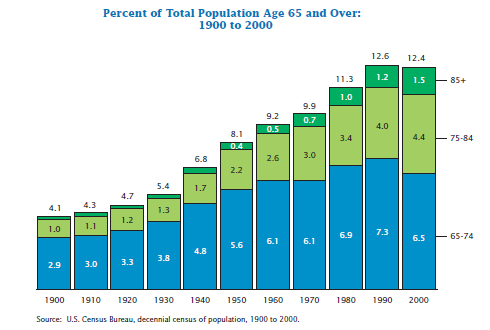You should spend about 20 minutes on this task.
The chart below shows the percentage of the total US population aged 65 and over between 1900 and 2000. Summarise the information by selecting and reporting the main features, and make comparisons where relevant.
You should write at least 150 words.

Sample Answer 1
The column graph summarises the percentages of elderly citizens in the USA who were above 64 years old between 1900 and 2000 based on the U.S. Census Bureau’s decennial census of population data.
Generally speaking, the ratio of senior citizens in the USA increased significantly over the period, and 65 to 74 years old citizens were the highest in percentage in terms of their ratio among elderly Americans.
According to the graph, four out of a hundred Americans were above 64 years old in 1900, most of whom were between 65 to 74 years old. Moreover, this decade’s ratio of people over 85 years old was very insignificant. After three decades, however, the elderly people ratio in the US reached over 5% and kept increasing until the end of the 20th century. Thus, almost one in ten US citizens was elderly in 1970, and 0.7% of them were 85 years old. The growth of senior citizens further accelerated after 1980 in the USA. Consequently, during the last two decades of the 20th century, the USA had been the home to 12% of senior citizens; almost 4.5% were between 75 to 84 years old, and 1.5% were above 85 years old.
Sample Answer 2
The column graph depicts the percentages of senior citizens in the USA throughout the 20th century according to the decennial census population data of the U.S. Census Bureau.
Generally speaking, elderly people in the USA increased from 1900 to 2000. 65 to 74 years old citizens were the highest percentage of elderly Americans during this time.
As can be seen in the chart, four out of every hundred Americans were over 64 years old in 1900. Moreover, this year’s ratio of people over 85 years old was insignificant. During the first three decades, the percentage of elderly people in the USA increased by merely 1%, and there was no change in the rate of citizens aged over 85 years.
Then in the next sixty years, the percentage of senior citizens surged to a maximum of over 12% of the total population. However, the number dropped slightly in the last ten years of the century. By 2000, most elderly people were between 65 to 74, which was 6.5%, and the citizens aged 85+ were only 1.5%.
Sample Answer 3
The chart shows the percentage of total population aged 65 and over in the U.S. between 1900 and 2000. In the year 1900 just over 4% of the population was aged over 65. However, by 1960 this figure had doubled.
The number of people aged between 75 and 84 remained fairly steady between 1900 and 1930, making up only 1-1.3% of the population. The figure began to rise more significantly in 1940 and by 1970 it had tripled to reach 3% of the population.
Although there was no change in the number of people aged 65 -74 between 1960 and 1970, the number of people aged 75 and over increased during this time. By the year 2000, 12.4% of the US population had reached the age of 65 or more, although this was slightly lower than in 1990 when it peaked at 12.6%.
The chart shows that today people in the U.S. can expect to live longer than in 1900. By the year 2000 more than 12% of the population had managed to live to the age of 65 and over compared to only 4.1% in 1900.
